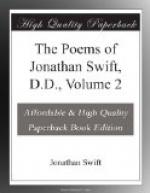[Footnote 1: Lord Nottingham’s family name.]
[Footnote 2: This was the Earl’s Christian name.]
THE WINDSOR PROPHECY[1] “About three months ago, at Windsor, a poor knight’s widow was buried in the cloisters. In digging the grave, the sexton struck against a small leaden coffer, about half a foot in length, and four inches wide. The poor man, expecting he had discovered a treasure, opened it with some difficulty; but found only a small parchment, rolled up very fast, put into a leather case; which case was tied at the top, and sealed with St. George, the impression on black wax, very rude and gothic. The parchment was carried to a gentleman of learning, who found in it the following lines, written in a black old English letter, and in the orthography of the age, which seems to be about two hundred years ago. I made a shift to obtain a copy of it; but the transcriber, I find, hath in many parts altered the spelling to the modern way. The original, as I am informed, is now in the hands of the ingenious Dr. Woodward, F. R. S. where, I suppose, the curious will not be refused the satisfaction of seeing it.
“The lines seem to be a sort of prophecy, and written in verse, as old prophecies usually are, but in a very hobbling kind of measure. Their meaning is very dark, if it be any at all; of which the learned reader can judge better than I: however it be, several persons were of opinion that they deserved to be published, both as they discover somewhat of the genius of a former age, and may be an amusement to the present.”—Swift.
The subject of this virulent satire was Elizabeth, Baroness Percy, daughter and heiress of Josceline, Earl of Northumberland, who died in 1670. She was born in 1666. In 1679 she was married to Henry Cavendish, Earl of Ogle, who died in 1680. In 1681, she married Thomas Thynne, a man of great wealth, a friend of the Duke of Monmouth and the Issachar of Dryden’s “Absalom and Achitophel.” A few months afterwards, in February 1681-2, Thynne was assassinated in the Haymarket by foreigners, who were devoted friends of Count Konigsmark, and appear to have acted under his direction. The Count had been in London shortly before Lady Ogle’s marriage to Thynne, and had then paid his addresses to her. He fled the day after the murder, but was brought back, and was tried with the principals as an accessory, but was acquitted. Four months after the murder of Thynne, his widow was married to Charles Seymour, Duke of Somerset, on 30th May, 1682, and ultimately became the favourite and friend of Queen Anne, and a zealous partisan of the Whig party. Hence Swift’s “Prophecy.” See “State Trials,” vol. ix, and “Notes and Queries,” 1st S., v. 269.—W. E. B.




